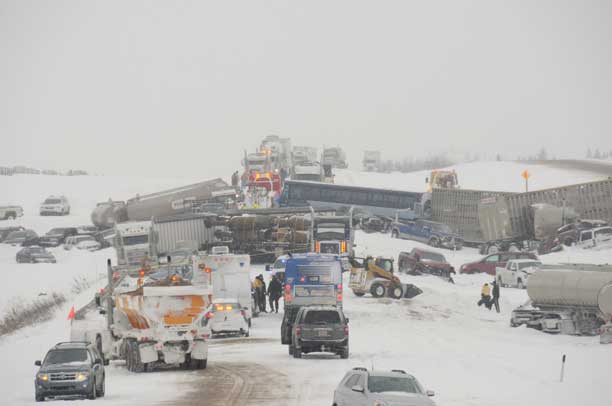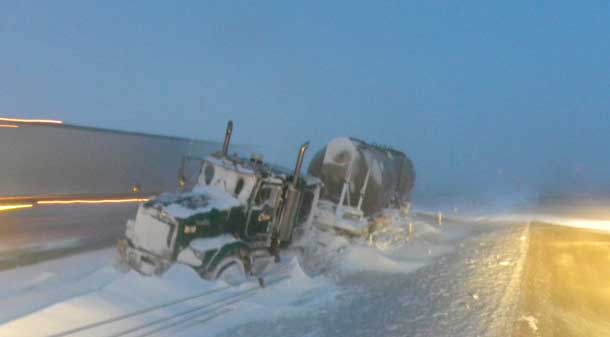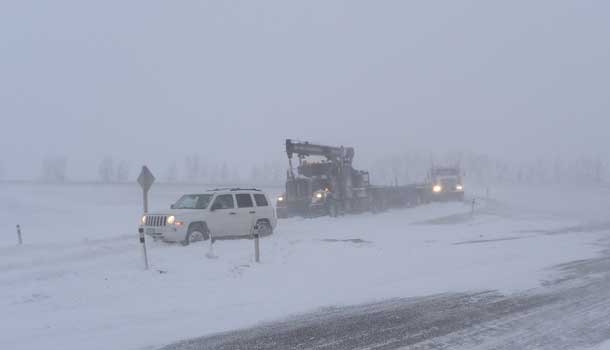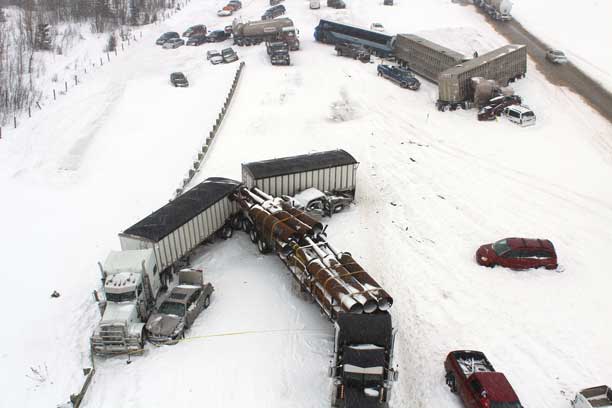
THUNDER BAY – Winter is on the way. The first snowfalls of winter have already fallen in parts of Northwestern Ontario. Manitoba, Saskatchewan and Alberta are expecting snow.
RCMP Superintendent Howard Eaton, Officer in Charge of “K” Division Traffic Services, and Superintendent James Stiles, Deputy Director Alberta Traffic Sheriffs are taking this opportunity to offer the following tips on how to make the transition from dry pavement driving to winter driving conditions, a little easier.
“Some drivers are unprepared for the annual transition from the dry pavement of summer to winter driving conditions that can include, snow and slush covered highways, black ice and blizzards” says Supt. Eaton. “This first snowfall is a reminder and an opportunity to get prepared for winter driving, which means preparing our vehicles and adjusting our driving”
Supt. Stiles, with the Alberta Sheriffs agrees, “Most Albertans do take the time to prepare their vehicles and modify their driving habits to accommodate for winter driving conditions, but for those who need a reminder we offer the following tips.”

Winter Driving Tips:
The Alberta government and its highway maintenance contractors work hard to keep Alberta’s highways clear and open to traffic during the winter. However, some severe storms exceed their ability to keep highways free of snow and ice. This may be caused by the amount of snow, timing or duration of the storm, high winds, freezing rain or a combination of all of these factors. Road closures are at the discretion of Alberta Government in consultation with enforcement partners. (adapted from Alberta Roadbuilders & Heavy Construction Assoc. Safer Winter Highways: Fact Sheet)

- Slow down when highway conditions are not ideal.
- The posted speed limit is intended for ideal road conditions. Even if the posted speed is 110 km/h, that doesn’t mean you should travel at that speed if road conditions or visibility are poor.
- Motorists have a legal obligation to drive according to road conditions.
- You can be charged with a traffic offence if you drive too fast for the conditions.
- Unless travel is absolutely necessary, stay off the roads during major storms.
- If you must travel, plan to take the safest, shortest route possible and ensure you have your winter emergency kit in the vehicle.
- Keep your headlights on all the time – don’t rely on daytime running lights.
- Low beams are more effective than high beams in fog or heavy snow conditions.
- Also, turning on your headlights will activate your tail lights making you more visible from behind.
- Ensure your vehicle is in a safe mechanical condition.
- It is not recommended to travel in winter conditions if your vehicle is equipped with summer tires. Traction is of the utmost importance.
- Never use cruise control in winter conditions.
- Avoid sudden moves by anticipating turns or lane changes.
- Abrupt changes in direction or slamming on the brakes could cause you to spin out of control.
- On a wet or slick surface, allow yourself at least three times the normal following distance to stop.
- Remember that bridge decks may be slippery even when other parts of the highway are not, since they are subject to greater temperature fluctuations.
- Know your braking system and how it reacts on ice.
- Always be gentle with braking pressure on slick roads.
Carry a Safety Kit in Your Vehicle
For your comfort, safety and peace of mind, you should carry an emergency road kit in your vehicle’s trunk or cargo space. Pack or replenish these supplies:
- Blanket or sleeping bag
- Extra clothing and footwear
- Emergency non-perishable food
- Candle in a deep tin
- Waterproof matches
- First aid kit
- Flashlight with extra batteries
- Fire extinguisher
- Booster cables
- Ice scraper & Snow brush
- Paper towels or rags
- Road map, Compass, GPS
- Sand, road salt or kitty litter, and
- Shovel
It is also important to keep your cell phone charged. Often that might be your lifeline for help.
Before heading out on any major trip it is always a positive idea to check the weather report, and the latest road conditions. In western Canada in the foothills and mountains of Alberta and British Columbia the weather can change fast. Across the prairies, a storm can whip up a blinding snow storm reducing visibility very fast.
In Northwestern Ontario, where there are still long stretches of roads where there is no cellular coverage, yet, having supplies in your vehicle can make the difference between life and death.
As winter draws it bead on our region, having taken the time to prepare now will save you time, save your friends and family the worry if you are on the road.
Benjamin Franklin said, “An ounce of prevention is worth a pound of cure”. When it comes to winter driving, his words still apply.








